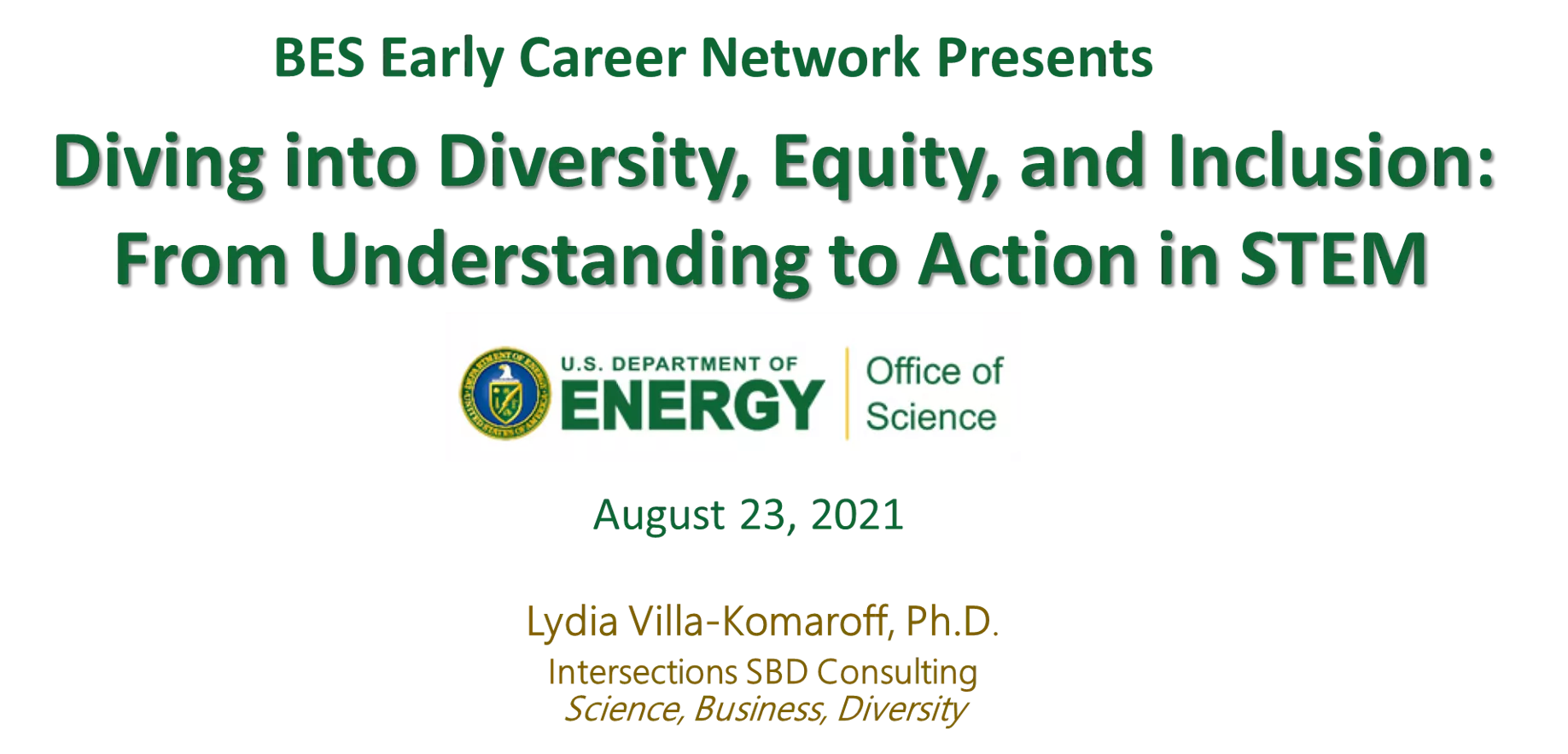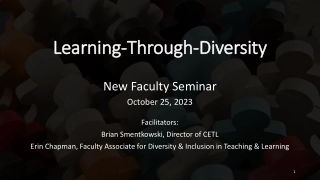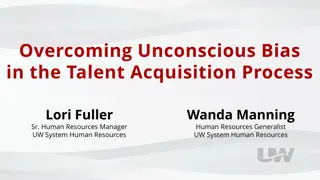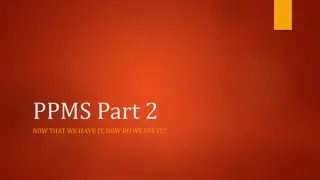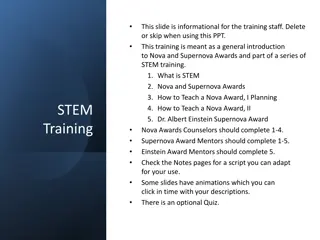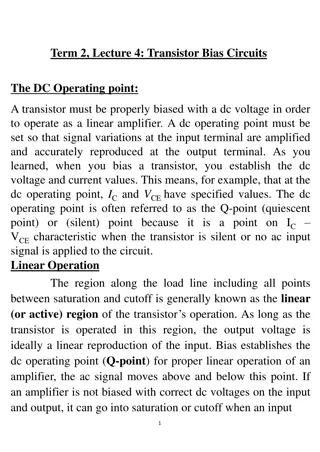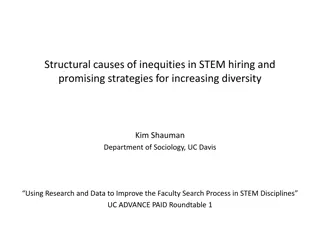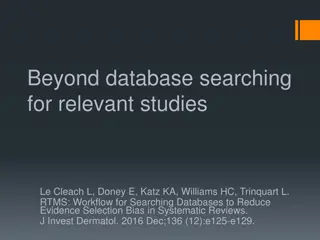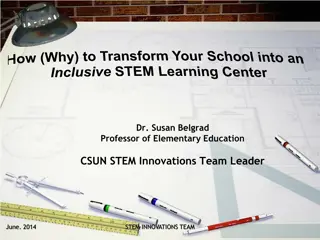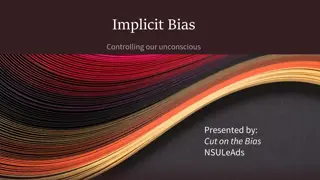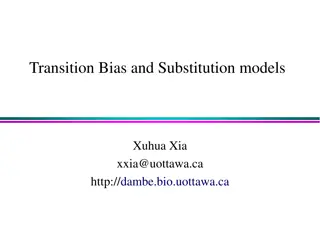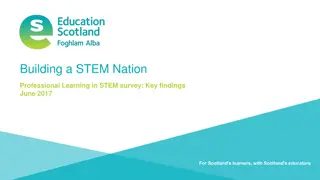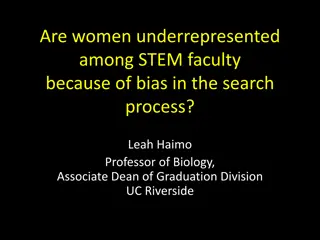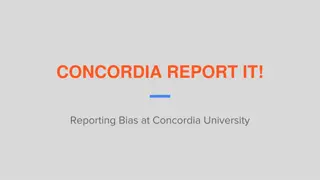Challenges in STEM Diversity and Implicit Bias
Teams and institutions benefit from diversity, yet individuals from historically excluded groups face obstacles in STEM environments. Implicit biases, gender biases, and perceptual errors influence decision-making and behavior. Addressing these issues is crucial for promoting inclusivity and equal opportunities in science and business.
Download Presentation

Please find below an Image/Link to download the presentation.
The content on the website is provided AS IS for your information and personal use only. It may not be sold, licensed, or shared on other websites without obtaining consent from the author.If you encounter any issues during the download, it is possible that the publisher has removed the file from their server.
You are allowed to download the files provided on this website for personal or commercial use, subject to the condition that they are used lawfully. All files are the property of their respective owners.
The content on the website is provided AS IS for your information and personal use only. It may not be sold, licensed, or shared on other websites without obtaining consent from the author.
E N D
Presentation Transcript
The Current Reality The Current Reality Teams and institutions benefit from diversity Talent is distributed equally, access and opportunity are not Individual STEMM professionals from historically excluded groups continue to be less likely to be successfully integrated into STEMM environments Generally, individuals from under-represented groups receive less mentorship or attention than their well- represented peers. INTERSECTIONS SCIENCE BUSINESS DIVERSITY
Implicit Bias: A Summary Data from many sciences support the long-standing recognition by psychologists and other social scientists that humans make systematic errors in judgement The human brain has evolved mechanisms to deal with the massive data provided by the senses Much human brain development occurs after birth, influenced by the environment it is embedded in That these mechanisms are the result of evolution does not mean that we cannot change behavior as needed in response to challenges in our world Scientists in the natural sciences have been particularly resistant to the notion that unconscious mental processes affect their decisions INTERSECTIONS SCIENCE BUSINESS DIVERSITY
Implicit Gender Biases Favor Male Students Moss-Racusin, Dovidio, Brescoll, Graham, Handelsman. PNAS 2012 faculty members of both genders appear to be affected by enduring cultural stereotypes about women s lack of science competence that translate into biases in student evaluation and mentoring. Moss-Racusin et al, PNAS 2012 Female (Jennifer) Male (John) Evaluation of male and female candidates with identical CV s INTERSECTIONS SCIENCE BUSINESS DIVERSITY
Optical Illusions are Perceptual Errors Optical Illusions are Perceptual Errors Adapted from Shepard, Mindsights, 1990 INTERSECTIONS SCIENCE BUSINESS DIVERSITY
Implicit Bias Stems from Associative Errors Reflexive associative thinking that results from our cultural milieu May be counter to what we believe about ourselves Mental content of which we are unaware Shared by all members of the culture Hidden (implicit) biases can guide behavior without our awareness Good people well intentioned, strive to align behavior with intentions, but often fail https://implicit.harvard.edu/implicit/ NASEM Webinar: The Science of Implicit Bias: Implications for Law and Policy https://vimeo.com/showcase/8500358 INTERSECTIONS SCIENCE BUSINESS DIVERSITY
Implicit Bias: an Example Implicit Bias: an Example We put down briefly in Khartoum, where we changed to an Ethiopian Airways flight to Addis. Here I experienced a rather strange sensation. As I was boarding the plane, I saw that the pilot was black. I had never seen a black pilot before, and the instant I did, I had to quell my panic. How could a black man fly an airplane? Nelson Mandela From: Long Walk to Freedom: The Autobiography of Nelson Mandela. Little, Brown and Company. INTERSECTIONS SCIENCE BUSINESS DIVERSITY
Two Systems of Thinking Fast, Automatic, Intuitive, or System One Operates automatically, unconsciously, rapidly Requires little or no effort No voluntary control, freewheeling Active all the time Any information automatically triggers related information Slow, Deliberate, Controlled, or System Two Allocates attention to effortful mental activities Requires energy Orderly, deliberative Normally operates in comfortable, low effort mode Generally accepts System 1 suggestions INTERSECTIONS SCIENCE BUSINESS DIVERSITY
Relationship between Structural Racism Relationship between Structural Racism and Implicit Biases and Implicit Biases Treatment of Native Americans by Spanish, English, French Enslavement of African peoples Chinese laborers on Transcontinental railroad Internment of Japanese during WWII Residential Segregation Unequal access to education, jobs, medical care, safety Disproportionate arrest and incarceration of Black and Brown people Osta & Vasquez, 2019 www.NationalEquityProject.org Icons from TheNounProject.com INTERSECTIONS SCIENCE BUSINESS DIVERSITY
Relationship between Structural Racism Relationship between Structural Racism and Implicit Biases and Implicit Biases Harsher punishment for students of color than for white students for the same behavior Black students more likely to be viewed as angry when they are debating or commenting We may be unwilling or uncomfortable raising current issues or events that affect PEERs (People Excluded because of Ethnicity or Race*) Kubota J. NASEM webinar on the Science of Implicit Bias. 22Mar1921 https://www.nationalacademies.org/event/01-12-2021/the-science- of-implicit-bias-implications-for-law-and-policy-a-workshop *Asai. Race Matters. Cell 181:754, 2020 INTERSECTIONS SCIENCE BUSINESS DIVERSITY
If we dont acknowledge our implicit biases they will direct our choices and we will call it fate Paraphrase of Carl Jung INTERSECTIONS SCIENCE BUSINESS DIVERSITY
Selected References Some selected references are pictured in the next 2 slides All publications from the National Academies Press can be downloaded as a PDF for free Thinking, Fast and Slow is very readable but is a very dense and long. You can get a great and entertaining synopsis of Kahneman s book in The Undoing Project by Michael Lewis, who wrote Moneyball. Blind Spot is the definitive work on implicit biases. It is a thorough but somewhat academic in tone. It was written by the people who introduced the term implicit bias and developed the implicit association test. Whistling Vivaldi shows the consequences when individuals from marginalized groups internalize cultural implicit biases. Thinking Race is a short (136 pages) highly readable book that spans human evolution to the current day and provides a succinct and dispassionate summary of the social myths and biological realities around race. Goldsby is an immunologist and entrepreneur, and Bateson is an anthropologist. INTERSECTIONS SCIENCE BUSINESS DIVERSITY
THE NATIONAL ACADEMIES PRESS www.nap.edu INTERSECTIONS SCIENCE BUSINESS DIVERSITY

 undefined
undefined

